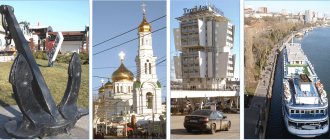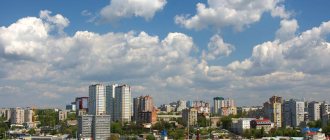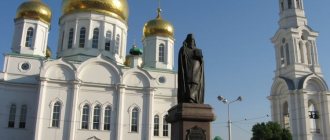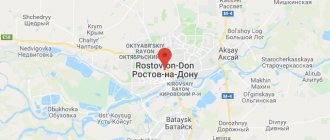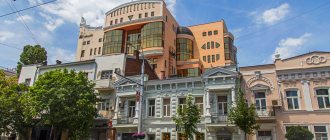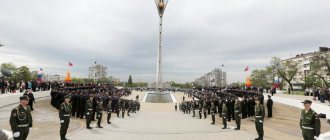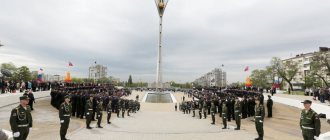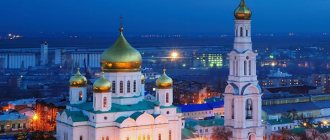A beautiful city, a city of over a million, with so much sun and warmth, spreads widely along a mighty river. Having experienced great difficulties, having experienced various events, he can tell a lot about his long and interesting life. It is enough to walk along the streets of Rostov-on-Don, squares with telling names, visit its museums and exhibitions with a wide variety of displays, and stroll along the country-famous embankment. It is impossible to get to know this city in one or two days. But, having come here once, you will want to return to be surprised again by its solidity and diversity.
Squares in Rostov-on-Don occupy a special place. Initially created as trading places, as the city developed, they acquired different purposes and, accordingly, individuality. There are a lot of them on the guidebook plan. Let's visit only a few of the most remarkable ones.
Cathedral Square
During the Azov campaigns, Peter the Great chose this place because of its advantageous location in the lower reaches of the Don. The defensive structures built here would reliably close the lands of the Russian Empire from restless neighbors - the Turks and Tatars. But the construction of the fortress took place only by decree of Catherine the First in 1761, and it was named in honor of Metropolitan of Rostov and Yaroslavl Dimitri, which gave the name to the city.
The oldest square in Rostov-on-Don is its historical center. The square is decorated with the Cathedral of the Nativity of the Blessed Virgin Mary, built in 1860 instead of a wooden church that burned down on this site. Today it is the main Cathedral of the city.
In 1890, the townspeople, using the money they collected, erected a monument to Tsar-Liberator Alexander II on their main square, which was destroyed in 1924. At the very end of the last century, a beautiful monument appeared here again, but this time to St. Demetrius of Rostov. This is one of the few monuments to holy saints in Russia.
At all times, the city bazaar was located here. Residents of Rostov, preserving traditions, still go here to the Central City Market.
Rostov-on-Don
Archaeological research dates the first settlements on the territory of modern Rostov-on-Don to the third millennium BC. The first written mentions of this area, the tract and the “Rich Well” spring, date back to the time of the Azov campaign (1695-1696) of Peter I. On December 15, 1749, Empress Elizaveta Petrovna issued a decree according to which on the right bank of the Don River 46 km above Temernitsk customs was established at the mouth of the river. In the spring of 1750, a pier, warehouse, quarantine, and garrison barracks were erected at the customs post.
In 1756, the international “Russian and Constantinople Trading Company” was founded. At this time, the Temernitsky port was the only Russian port in the south of the empire, through which all trade with the countries of the Mediterranean basin was conducted. The lower reaches of the Don were constantly subject to Turkish raids. As a result, in 1760-1761, construction of a fortress began at the “Rich Well” tract, according to the design of engineer-captain I. Vedenev. The direct supervision of the work was carried out by military engineer A. I. Rigelman. By decree of Empress Elizabeth Petrovna of April 6, 1761, the new fortress received the name of the holy Metropolitan of Rostov and Yaroslavl Dimitri.
In 1779, Armenian immigrants from the Crimean Peninsula, settled in these places by the will of Empress Catherine II, founded the settlement of Nor-Nakhichevan to the east of the fortress named after Demetrius of Rostov.
After the Crimean Khanate annexed the Russian Empire, the fortress, which was armed with 238 cannons, lost its military significance. On August 9, 1797, the Rostov fortress and Nakhichevan became part of the Rostov district of the Novorossiysk province.
By decree of Alexander I of August 17, 1807, the Rostov fortress received the status of a county town.
In 1835, by decree of the emperor, the fortress named after Demetrius of Rostov was finally abolished, and the lands it occupied were transferred to the city. Since 1838, the city of Nakhichevan began to be called Nakhichevan-on-Don. In 1887, the city of Rostov became part of the Don Army Region.
In 1865, the first water supply system was put into operation in Rostov. Since 1886, telephone communications began to function in the city, a horse-drawn railway appeared in 1887, and electric lighting appeared in 1896.
During the Civil War in 1918-1920, the city of Rostov was one of the centers of the White movement. On October 26, 1917, General Kaledin declared martial law on the Don. On December 2, 1917, Cossack units under the command of General Kaledin occupied Rostov, and on December 25, 1917 (January 7, 1918) the creation of the Volunteer Army was announced. At the end of February 1918, units of the Red Army occupied the cities of Rostov and Novocherkassk, and on March 23, 1918, the Don Soviet Republic was proclaimed as part of the RSFSR. However, already on May 8, 1918, the Cossack formations of military ataman P. N. Krasnov and German units occupied Rostov, as a result of which the Don Soviet Republic ceased to exist.
On January 10, 1920, troops of the 1st Cavalry Army under the command of S. M. Budyonny occupied Rostov. From that moment on, Soviet power was established in the city.
The year 1926 was marked by the laying of the foundation of a giant of domestic agricultural engineering in Rostov -. In accordance with the resolution of the commission of the All-Russian Central Executive Committee of the USSR dated December 28, 1928, the city of Nakhichevan-on-Don merged with the city of Rostov and became the Proletarsky district of the city of Rostov-on-Don. Since September 1937, the city became the administrative center of the newly formed Rostov region.
On November 20, 1941, German troops with 13 and 14 tank divisions, 60 motorized infantry divisions and 1 SS division under the overall command of E. von Mackensen, breaking the resistance of units of the 56th Red Army Army, occupied the city of Rostov-on-Don. However, already on November 28-29, 1941, troops of the 9th Army under the command of Major General F. M. Kharitonov and the 56th Army under the command of Lieutenant General F. N. Remizov liberated the city from the German invaders.
On July 23-24, 1942, as a result of the catastrophic defeat of the Red Army near Kharkov (commander-in-chief of the troops of the South-Western direction - Marshal S.K. Timoshenko, representative of the Headquarters - N.S. Khrushchev), Rostov-on-Don was occupied for the second time by German troops by forces of 17 Wehrmacht army.
On the night of February 9, 1943, the 11th Guards Cossack Cavalry Don Division under the command of General S.I. Gorshkov crossed the Dead Donets River and occupied the village of Nizhne-Gnilovskaya, a suburb of Rostov-on-Don. On February 14, 1943, units of the 28th and 51st armies finally liberated the city from German troops.
During the occupation, Rostov-on-Don suffered significantly. More than 40 thousand residents died, in Zmievskaya Balka alone 27 thousand Rostovites were killed, 53 thousand people were driven away to work in Germany, about 12 thousand houses and all bridges were destroyed.
In 1958, the first television tower was built in Rostov-on-Don, and in 1965 the new Voroshilovsky Bridge was opened. In 1987, the city's millionth resident was born.
Soviet Square
This is one of the central squares of Rostov-on-Don, known in the 19th century as New Bazaar Square. Alexander Nevsky Cathedral, which was the main building of the ensemble, was demolished after the revolution. During the war, most of the buildings were destroyed, and the appearance of the square was created anew.
Today it is a green island in the heart of a bustling city. Tall trees along the perimeter, well-groomed flower beds and tiled paths attract townspeople here. Here it is customary to meet and stroll leisurely, admiring the flowering of the planted plants.
The sculptural composition in memory of the Red Army soldiers, in the center of which USSR Marshal S. M. Budyonny rises on horseback, surrounded by his subordinates, was made by the famous sculptor E. V. Vuchetich.
Sights of Rostov
Assumption Cathedral and belfry. Located near the Rostov Kremlin. The cathedral was built in the 16th century on the site of a much older church that burned down. The concept is traditional for the architecture of the Vladimir-Suzdal principality: a five-domed temple, an arcaded pattern of walls.
The belfry is almost two centuries younger, but is known even more. Each of the 13 bells has its own sound, and together they are capable of beating dozens of acoustic pieces. They work together like your orchestra, amazing with the variety of available melodies.
The largest bell weighs 32 tons, but who weighed it? But you can listen for a long time... Until they invite you back onto the bus. Yes, you may have heard: in the same “Ivan Vasilyevich” Yuri Yakovlev created what melodies!
- Excursion to Rostov the Great and Pereslavl-Zalessky
In atheistic Soviet times, she released the album “Rostov Bells,” which became a hit and was then reissued many times.
Rostov Kremlin
Another prominent landmark of the ancient city. It was originally created as the residence of the metropolitan, which fundamentally distinguishes it from other Russian fortresses. It was built at the end of the 17th century. And although it followed the tradition and looks like a citadel, it never had defensive significance.
This does not spoil it - we agree. Who, really, will count the loopholes and pay attention to other nuances? The Rostov Kremlin looks interesting - it is an example of the peculiar architectural eclecticism of pre-Petrine times. And according to Russians, it is one of the symbols of the country, very recognizable!
In general, the city is like a textbook on the history of Russia. And if you spend a little bit of your time and a little money, it will literally start playing. Scant information from a school textbook is one thing. The story of an erudite man in love with his “small” Motherland is completely different: rostov-velikiy-zhivaya-istoriya-drevnego-goroda.
The Kremlin, by the way, still retains the status of a state museum and is not under the jurisdiction of the Russian Orthodox Church. During the visit, you can explore a number of churches, premises for various purposes, as well as a collection of religious art.
Entrance inside costs 70 RUB, and then everything depends on your interests. The most intense program includes a walk along the walls, visits to churches and the Museum of Church Antiquities - a ticket will cost 220 rubles. By the way: you are allowed to climb and wander along the walls only from May 1 to October 1: www.rostmuseum.ru/posetitelyam/stoimost-biletov/.
A huge collection of painted enamels (more than 3,000 units) was collected by the enamel museum located on the territory of the Kremlin. Rostov enamel is a brand known for more than 250 years, one of the emblems of the city and region.
Dimitriev Monastery
For tourists who are not constrained by time constraints, we recommend taking a look from the inside at the Spaso-Yakovlevsky Dimitriev Monastery of the 14th century. In 1991, the monastery was returned to the church and brought back to normal. Excursions are provided for pilgrimage groups.
Individual visitors can also enter the territory. And they obviously won’t regret it: the monastery is large, beautiful and located in a very good location, right on the shore of Lake Nero. While walking along the walls, you will stop more than once to enjoy the views.
Museum of Rostov Merchants
Located in a cozy mansion on Leninskaya Street, 32 - it’s a 5-7 minute walk from the Kremlin. Inside there is an exhibition dedicated to the local merchant family of the Kekins. But it tells in general about the history, traditions and life of the Rostov merchants.
For some reason the museum is not open on Mondays and Tuesdays... Or is the flow of people too small?
Theater Square in Rostov-on-Don
What was once a place located on the very outskirts, in a city wasteland, has now become the main, most significant square of the city. Holidays, events, parades, concerts, fireworks and much more that take place here today attract tens of thousands of citizens. Of course, this is a beautiful, well-groomed and attractive place for tourists and local residents.
Theater Square in Rostov-on-Don is easy to find by the 42-meter stele of the memorial, visible from afar, dedicated to the liberation of the city from the Nazis. At the very top of the composition are the goddess of victory Nike and the Order of the Patriotic War.
The square, which initially bore the name of the Revolution, was renamed in the mid-thirties of the last century upon completion of the construction of a new building for the Drama Theater. A. M. Gorky. The first thing that strikes you upon inspection is that the theater building is made in the form of a caterpillar tractor. Due to its unusual shape, its copy was exhibited in England, in the Museum of Architecture.
Not far from the theater there is a complex of fountains created by sculptor E. V. Vuchetich. The building of the North Caucasian Railway, built at the beginning of the twentieth century, is also an architectural monument.
The square is always crowded. It’s nice to stroll here, admire the beauty of the city, and relax in one of the many cafes or restaurants.
Where to stay
You can spend the night in Rostov the Great not only in an ordinary hotel or apartment - the Trinity-Sergius Varnitsky Monastery will also gladly accommodate city guests. However, don’t count on private rooms. And you will have to get to the city center!
But staying at the guest house “On Valakh”, you can walk to the entrance to the local Kremlin in 3-4 minutes. The house is decorated in traditional Russian style and is very well maintained. The rooms have a standard set of amenities and even more: a refrigerator and microwave.
In a beautiful location right on the shore of Lake Nero there is a brand new hotel with the not-so-Russian name Bravis Holiday Park. But those who stayed praise the cleanliness of the rooms and the views from the windows. And the presence of a good restaurant is an important bonus for a traveler who is tired from the road.
Working area
The working area of Rostov-on-Don is located in the Zheleznodorozhny district of the city. Surrounded mainly by old residential buildings, it is a recreation area, or rather a small square, where local residents come. There is a circular movement of cars around the square, and the square itself, like an island of safety and peace, invites you to take a walk. There are children's playgrounds, pavilions selling drinks and ice cream, and fountains. The area is old, inhabited, and therefore very green and cozy. In the surrounding houses there are numerous shops and services that ensure the normal functioning of people.
Komsomolskaya Square in Rostov-on-Don
A fighting city with a respectable military past has survived all hardships together with its country. The memory of this is captured by numerous sculptural ensembles, memorials and monuments. On one of the city squares in 1969, on the initiative of Komsomol members, a black marble stele was erected, dedicated to the feat of young Rostovites in the Patriotic War. The square also began to be called Komsomolskaya. It is impossible to look without pain at the remains of a bas-relief depicting a wounded young guy clutching a weapon in his hands, in which there are no cartridges left. A lot of people died on Rostov soil, closing the “gate to the Caucasus” from the Nazis. I would like to hope that someday the restored stele will be a worthy monument to those who died for their country.
History of the city of Rostov-on-Don
Another river flows in the vicinity of the city - Temernik. In 1749, the Russian Empress Elizaveta Petrovna signed a Decree establishing the Temernitsa State Customs House. A port was built here, and two decades later the construction of a military fortress began, designed to protect the southern borders of Russia. The location was not chosen by chance - the convenient geographical location promised active economic development of the city. A port appeared here, where merchants from different countries flocked. Subsequently, Catherine II issued a decree naming the fortress after the saint, enlightener and sage Demetrius of Rostov. This is how merchant Rostov appeared, and by the 30s of the 20th century the city was one of the ten largest in the USSR.
